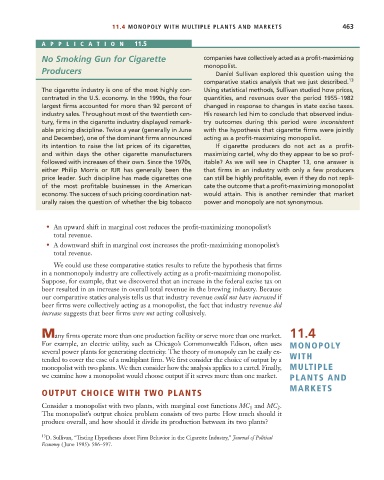Page 489 - Microeconomics, Fourth Edition
P. 489
c11monopolyandmonopsony.qxd 7/14/10 7:58 PM Page 463
11.4 MONOPOLY WITH MULTIPLE PLANTS AND MARKETS 463
APPLICA TION 11.5
No Smoking Gun for Cigarette companies have collectively acted as a profit-maximizing
monopolist.
Producers Daniel Sullivan explored this question using the
comparative statics analysis that we just described. 13
The cigarette industry is one of the most highly con- Using statistical methods, Sullivan studied how prices,
centrated in the U.S. economy. In the 1990s, the four quantities, and revenues over the period 1955–1982
largest firms accounted for more than 92 percent of changed in response to changes in state excise taxes.
industry sales. Throughout most of the twentieth cen- His research led him to conclude that observed indus-
tury, firms in the cigarette industry displayed remark- try outcomes during this period were inconsistent
able pricing discipline. Twice a year (generally in June with the hypothesis that cigarette firms were jointly
and December), one of the dominant firms announced acting as a profit-maximizing monopolist.
its intention to raise the list prices of its cigarettes, If cigarette producers do not act as a profit-
and within days the other cigarette manufacturers maximizing cartel, why do they appear to be so prof-
followed with increases of their own. Since the 1970s, itable? As we will see in Chapter 13, one answer is
either Philip Morris or RJR has generally been the that firms in an industry with only a few producers
price leader. Such discipline has made cigarettes one can still be highly profitable, even if they do not repli-
of the most profitable businesses in the American cate the outcome that a profit-maximizing monopolist
economy. The success of such pricing coordination nat- would attain. This is another reminder that market
urally raises the question of whether the big tobacco power and monopoly are not synonymous.
• An upward shift in marginal cost reduces the profit-maximizing monopolist’s
total revenue.
• A downward shift in marginal cost increases the profit-maximizing monopolist’s
total revenue.
We could use these comparative statics results to refute the hypothesis that firms
in a nonmonopoly industry are collectively acting as a profit-maximizing monopolist.
Suppose, for example, that we discovered that an increase in the federal excise tax on
beer resulted in an increase in overall total revenue in the brewing industry. Because
our comparative statics analysis tells us that industry revenue could not have increased if
beer firms were collectively acting as a monopolist, the fact that industry revenue did
increase suggests that beer firms were not acting collusively.
Many firms operate more than one production facility or serve more than one market. 11.4
For example, an electric utility, such as Chicago’s Commonwealth Edison, often uses MONOPOLY
several power plants for generating electricity. The theory of monopoly can be easily ex-
tended to cover the case of a multiplant firm. We first consider the choice of output by a WITH
monopolist with two plants. We then consider how the analysis applies to a cartel. Finally, MULTIPLE
we examine how a monopolist would choose output if it serves more than one market. PLANTS AND
MARKETS
OUTPUT CHOICE WITH TWO PLANTS
Consider a monopolist with two plants, with marginal cost functions MC and MC .
2
1
The monopolist’s output choice problem consists of two parts: How much should it
produce overall, and how should it divide its production between its two plants?
13 D. Sullivan, “Testing Hypotheses about Firm Behavior in the Cigarette Industry,” Journal of Political
Economy ( June 1985): 586–597.

